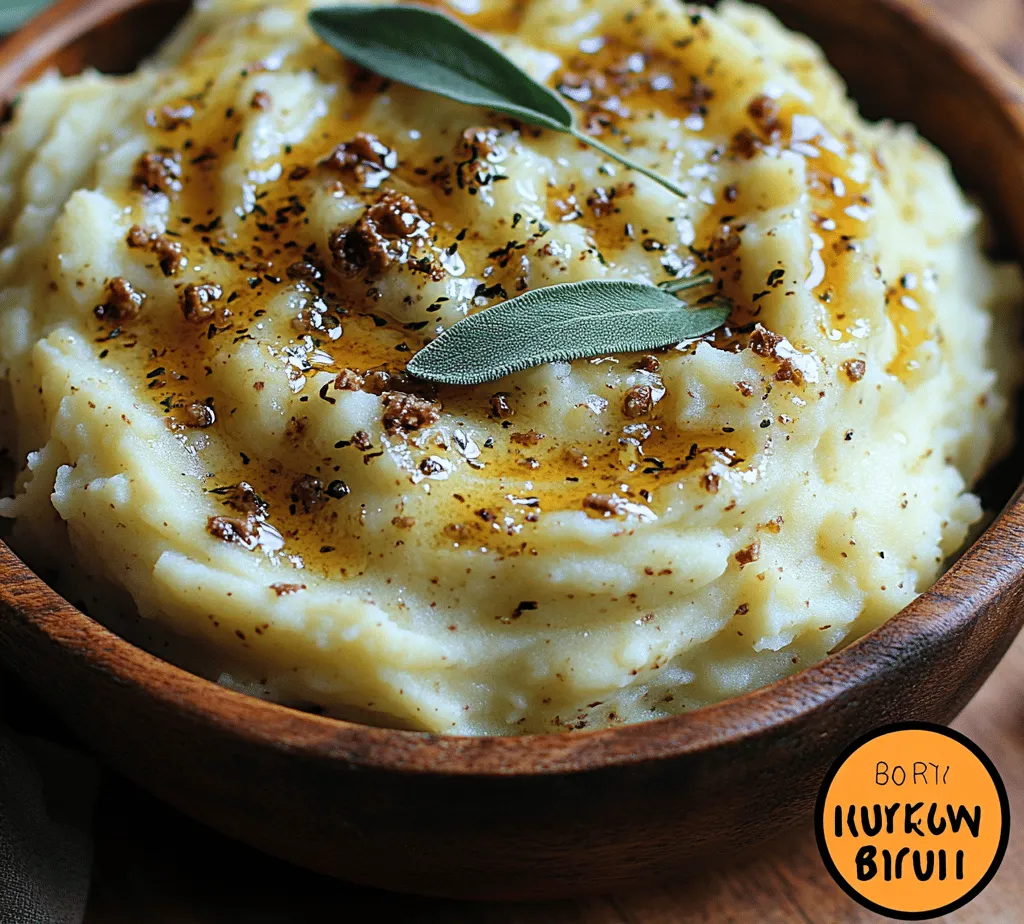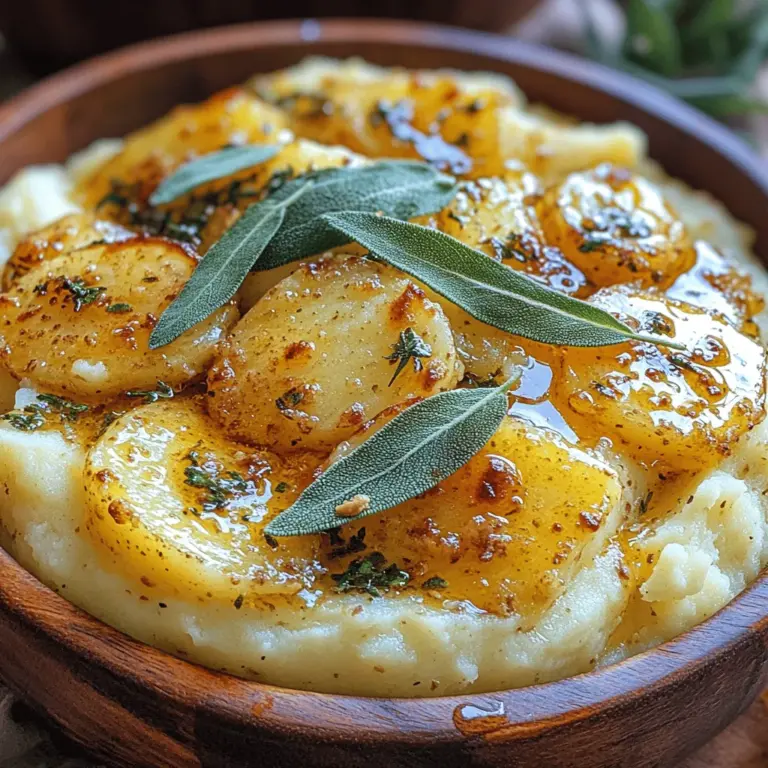Delve into the comforting world of mashed potatoes with our exquisite Brown Butter Sage Mashed Potatoes recipe. This dish elevates the classic comfort food by infusing it with nutty brown butter and fragrant sage, making it a perfect accompaniment to any meal, particularly during the holiday season. If you’re looking to impress your guests or elevate your family dinner, this recipe is the way to go. In this article, we will explore the origins of mashed potatoes, the benefits of using brown butter, and the unique flavor profile that fresh sage brings to this dish. Let’s embark on a culinary journey that promises to delight your taste buds and impress your guests.
Understanding Mashed Potatoes
Exploring the History of Mashed Potatoes
Mashed potatoes, in one form or another, have been enjoyed for centuries, with roots tracing back to the Andean region of South America, where the potato was first cultivated. The Spanish introduced potatoes to Europe in the late 16th century, and by the 18th century, mashed potatoes were gaining popularity among the French aristocracy. The technique of mashing potatoes was refined over the years, and it quickly became a staple in many households.
In the United States, mashed potatoes gained prominence as comfort food in the 19th century, especially after the potato became widely cultivated. The dish has since evolved, with various regional adaptations emerging, including the creamy, buttery versions we know today. The beauty of mashed potatoes lies in their versatility; they can be flavored with a myriad of ingredients, making them a canvas for culinary creativity.
Significance of Mashed Potatoes in Different Cultures
Mashed potatoes hold a special place in the hearts and kitchens of many cultures. In the United States, they are often associated with Thanksgiving, served alongside turkey and gravy. In British cuisine, mashed potatoes are a traditional accompaniment to dishes such as bangers and mash or shepherd’s pie. In France, “purée” refers to mashed potatoes, which are typically prepared with butter and cream, highlighting the French culinary tradition of rich and indulgent flavors.
Across cultures, the humble potato has transcended its status as a simple side dish to become a beloved comfort food. The creamy texture and rich flavor of mashed potatoes provide a sense of warmth and nostalgia, making them a go-to dish for family gatherings and celebrations.
The Evolution of Mashed Potatoes and Its Variations
As culinary innovation continues, mashed potatoes have evolved to incorporate various techniques and ingredients. From the classic version made with just butter and milk to gourmet interpretations featuring truffle oil, roasted garlic, or even cheese, there’s a mashed potato recipe for everyone. The introduction of brown butter and fresh herbs, like sage, adds a unique twist to the traditional recipe, creating a dish that is both comforting and sophisticated.
In recent years, health-conscious trends have also influenced the evolution of mashed potatoes. Variations using sweet potatoes, cauliflower, or even avocado have become popular, appealing to those looking for lighter alternatives. However, the classic mashed potato remains a timeless favorite, cherished for its simplicity and heartwarming qualities.
Ingredient Breakdown
To create our Brown Butter Sage Mashed Potatoes, it’s essential to choose the right ingredients to achieve the best flavor and texture. Here’s a breakdown of the key components:
The Star Ingredient: Yukon Gold Potatoes
When it comes to mashed potatoes, the choice of potato makes all the difference. Yukon Gold potatoes are the star of this recipe due to their creamy texture and buttery flavor. Unlike starchy potatoes, such as russets, Yukon Golds have a medium starch content, which helps them achieve a perfect balance of creaminess without becoming gluey. Their golden skin and flesh lend a beautiful hue to the dish, making it visually appealing as well. Boasting a naturally rich flavor, Yukon Gold potatoes require minimal seasoning, allowing the other ingredients to shine through.
Why Choose Unsalted Butter?
Butter is a crucial ingredient in mashed potatoes, providing richness and depth of flavor. For our Brown Butter Sage Mashed Potatoes, unsalted butter is the preferred choice. Using unsalted butter allows you to control the saltiness of the dish, ensuring that it doesn’t become overpowering. The process of browning the butter also enhances its flavor, adding a nutty, caramelized note that complements the earthy sage beautifully. Additionally, opting for high-quality butter will yield the best results, as it contributes to the overall taste and texture of the mashed potatoes.
The Role of Heavy Cream and Whole Milk
To achieve the perfect creamy consistency in our mashed potatoes, a combination of heavy cream and whole milk is used. Heavy cream adds a luxurious richness, while whole milk helps to lighten the texture, making the potatoes fluffy and smooth. This balance is vital for creating a velvety mouthfeel that is both satisfying and indulgent. Feel free to adjust the ratios based on your personal preference; however, the combination of these two dairy products is key to achieving the perfect blend of creaminess and flavor.
Understanding Garlic Powder and Its Flavor Contribution
Garlic powder is a subtle yet impactful addition to our Brown Butter Sage Mashed Potatoes. While fresh garlic can be used, garlic powder provides a more uniform flavor without the risk of bitterness that may come from overcooking fresh garlic. It adds a warm, garlicky undertone that enhances the overall taste of the dish without overshadowing the star ingredients. Garlic powder also blends seamlessly into the creamy potatoes, ensuring that each bite is infused with its savory essence.
The Importance of Fresh Sage in Cooking
Fresh sage is the aromatic herb that takes our mashed potatoes to the next level. Known for its earthy, slightly peppery flavor, sage pairs exceptionally well with rich dishes, making it a perfect complement to the brown butter. The process of browning the butter infuses the sage’s aromatic oils, resulting in a fragrant and flavorful mash that elevates the dish from ordinary to extraordinary. When selecting sage, look for vibrant, green leaves that are free from blemishes. Fresh herbs are always preferable, as they impart a more robust flavor compared to dried herbs.
Preparing the Brown Butter Sage Mashed Potatoes
Now that we’ve covered the essential ingredients for our Brown Butter Sage Mashed Potatoes, let’s dive into the preparation process. A few essential kitchen tools will make your cooking experience smoother and more enjoyable.
Essential Kitchen Tools and Equipment
To prepare this delightful dish, you will need the following kitchen tools:
1. Large Pot: A sturdy pot for boiling the potatoes.
2. Colander: For draining the potatoes after boiling.
3. Potato Masher or Ricer: To achieve the desired texture for your mashed potatoes.
4. Saucepan: For browning the butter and sautéing the sage.
5. Wooden Spoon or Spatula: Useful for stirring and combining ingredients.
6. Measuring Cups and Spoons: For accurately measuring your ingredients.
Having these tools on hand will streamline your cooking process and ensure that you can create the most delicious Brown Butter Sage Mashed Potatoes with ease.
Step-by-Step Guide to Boiling Potatoes
1. Prepare the Potatoes: Start by washing the Yukon Gold potatoes under cold running water to remove any dirt. There’s no need to peel them, as the skin adds flavor and texture. Cut the potatoes into even-sized chunks (about 1-2 inches) to ensure they cook evenly.
2. Boil the Potatoes: Place the cut potatoes into a large pot and cover them with cold water. Add a generous pinch of salt to the water, which will enhance the flavor of the potatoes. Bring the water to a boil over high heat, then reduce the heat to medium, allowing the potatoes to simmer. Cook for about 15-20 minutes or until the potatoes are fork-tender.
3. Drain and Steam Dry: Once the potatoes are cooked, drain them in a colander. To remove excess moisture, return the drained potatoes to the pot and place it back on low heat for a minute or two. This step helps steam off any residual water, ensuring your mashed potatoes are not watery.
How to Achieve Perfectly Browned Butter
1. Melt the Butter: In a saucepan over medium heat, add the unsalted butter. Allow it to melt slowly, stirring occasionally with a wooden spoon to promote even cooking.
2. Watch for Color: As the butter melts, it will begin to bubble and foam. Continue to cook, stirring frequently, until the butter turns a golden brown color and develops a nutty aroma. This process usually takes about 5-7 minutes. Be careful not to let the butter burn, as this can result in a bitter flavor.
3. Add Fresh Sage: Once the butter reaches the desired brown color, immediately add the fresh sage leaves to the saucepan. The leaves will sizzle and infuse the butter with their aromatic oils. Sauté for about 30 seconds until the sage becomes fragrant.
Now that you have prepared the brown butter and boiled the potatoes, you’re well on your way to creating a stunning side dish that will leave your guests raving about your culinary skills. The next steps will guide you through the final assembly of your Brown Butter Sage Mashed Potatoes, ensuring they are rich, creamy, and full of flavor.

Sautéing Sage: Techniques for Maximum Flavor
To elevate your Brown Butter Sage Mashed Potatoes, the way you prepare the sage is crucial. Fresh sage leaves are the star of this dish, adding an aromatic flavor that perfectly complements the nuttiness of the brown butter and the creaminess of the potatoes. Here are some techniques to maximize sage’s flavor in your recipe:
1. Choosing Fresh Sage: Fresh sage leaves should be vibrant and not wilted. This ensures you get the most potent flavor. Dried sage can be used in a pinch, but fresh leaves provide a brighter taste.
2. Chiffonade Technique: For a more refined presentation and flavor release, consider the chiffonade technique. Stack the sage leaves, roll them tightly, and slice them thinly. This increases the surface area and helps release their essential oils, enhancing their flavor.
3. Sautéing Method: In a small skillet, melt a bit of unsalted butter over medium heat. Once melted, add the chiffonade sage leaves and cook until they are crisp and fragrant, about 2-3 minutes. Be careful not to burn them; you want a golden hue that will add depth to your dish.
4. Infusion: For an even deeper flavor, you can infuse the butter with sage before browning it. Simply add the sage leaves to the butter as it melts, allowing them to impart their flavor. Once you achieve a nutty aroma and a light brown color, remove the sage before combining it with the potatoes.
Mastering the Art of Mashing Potatoes
The secret to perfect mashed potatoes lies in how you mash them. Here are some expert tips to ensure your Brown Butter Sage Mashed Potatoes achieve that creamy, velvety texture:
1. Choosing the Right Potatoes: The best potatoes for mashing are starchy varieties, such as Russets or Yukon Golds. They break down easily and absorb flavors well, creating a smoother texture.
2. Cooking Method: Boil the potatoes in salted water until they are fork-tender. This usually takes about 15-20 minutes. Avoid overcooking, as this can lead to watery mashed potatoes.
3. Draining and Drying: Once cooked, drain the potatoes and return them to the pot for a minute or two. This allows excess moisture to evaporate, preventing your mashed potatoes from becoming gummy.
4. Mashing Technique: Use a potato masher, ricer, or food mill for the best results. A food mill will produce the smoothest texture, while a ricer gives a fluffy finish. Avoid using a blender or food processor, as these can overwork the potatoes, resulting in a gluey texture.
Combining Flavors for a Creamy Delight
Now that your potatoes are perfectly mashed and your sage is sautéed, it’s time to combine the flavors. Follow these steps for the best results:
1. Incorporating Brown Butter: Slowly drizzle the warm brown butter into the mashed potatoes. The heat will help soften the potatoes, making it easier to mix without overworking them.
2. Adding Dairy: Use a combination of heavy cream and sour cream or cream cheese for added richness. Start with a small amount and gradually increase until you reach your desired creaminess.
3. Mixing Techniques: Gently fold in the brown butter and dairy using a spatula or wooden spoon. This method prevents excessive mixing, ensuring a fluffy texture.
The Importance of Temperature in Combining Ingredients
Temperature plays a significant role in achieving the perfect mashed potatoes. Here are a few considerations:
– Warm Potatoes: Always combine ingredients while the potatoes are still warm. This helps them absorb the flavors of the butter and cream more effectively.
– Room Temperature Dairy: If using cold dairy products, allow them to come to room temperature before adding them to the potatoes. Cold ingredients can cause the potatoes to firm up and lose their creamy consistency.
Adjusting Seasonings: A Personal Touch
Seasoning is key to enhancing the flavors in your Brown Butter Sage Mashed Potatoes. Here’s how to ensure they are perfectly seasoned:
1. Salt and Pepper: Start with generous amounts of salt and freshly cracked black pepper. Taste as you mix, allowing yourself to adjust until you achieve the flavor profile you desire.
2. Nutmeg Addition: A pinch of freshly grated nutmeg can add warmth and complexity to the dish. It pairs beautifully with the sage and enhances the overall flavor.
3. Taste Test: Always taste your mashed potatoes before serving. This is your chance to adjust seasonings or add more brown butter for richness.
How to Achieve the Perfect Creamy Texture
Achieving the ideal creamy texture in your mashed potatoes requires attention to detail:
– Gradual Mixing: When adding liquids, incorporate them slowly. This ensures you don’t accidentally add too much and create a runny consistency.
– Avoid Overworking: The more you mix, the more starch is released from the potatoes, leading to a gummy texture. Mix just until combined, and allow the warmth of the potatoes to help meld the flavors.
Serving Suggestions
Once your Brown Butter Sage Mashed Potatoes are prepared, it’s time to think about how to present them. Here are some creative ideas:
Presentation Tips for a Beautiful Serving Dish
– Use a Serving Bowl: Transfer your mashed potatoes to a warm, decorative serving bowl. This keeps them warm and adds an elegant touch to your table.
– Create a Well: Use the back of a spoon to create a small well in the center of the potatoes. This not only looks appealing but also provides a perfect spot to drizzle a little extra brown butter or olive oil.
Pairing Brown Butter Sage Mashed Potatoes with Main Dishes
These mashed potatoes are incredibly versatile and can be paired with various main dishes:
– Roasted Meats: They work wonderfully with roasted chicken, turkey, or beef. The flavors of the brown butter and sage complement the savory notes of roasted meats beautifully.
– Vegetarian Options: Serve them alongside roasted vegetables, creamy mushroom dishes, or hearty lentil loaves for a satisfying vegetarian meal.
Creative Garnishes to Enhance Visual Appeal
– Sautéed Sage Leaves: Reserve a few of the sautéed sage leaves to use as a garnish. Their crispiness adds a delightful texture and a pop of color.
– Chopped Chives or Parsley: A sprinkle of fresh herbs can brighten the dish and add a splash of color.
– Extra Brown Butter Drizzle: A final drizzle of brown butter on top right before serving gives a beautiful sheen and enhances the flavor profile.
Nutritional Benefits of Brown Butter Sage Mashed Potatoes
While comfort food often conjures images of indulgence, Brown Butter Sage Mashed Potatoes can also be nutritious. Understanding their nutritional profile and potential health benefits can help you enjoy them guilt-free.
Understanding the Nutritional Profile
These mashed potatoes provide a good source of carbohydrates, essential for energy, along with vitamins C and B6, potassium, and fiber, particularly when the skin is left on.
Potential Health Benefits of Sage
Sage is not only a flavorful herb but also offers several health benefits:
– Antioxidant Properties: Sage contains antioxidants that can help combat oxidative stress in the body.
– Anti-Inflammatory Effects: The compounds in sage may help reduce inflammation, promoting overall health.
– Cognitive Benefits: Studies suggest that sage may support cognitive function and memory, making it a beneficial addition to your diet.
Balancing Comfort Food with Nutritional Needs
While mashed potatoes can be calorie-dense, you can balance indulgence with nutrition by making mindful choices:
– Portion Control: Enjoy a smaller serving alongside a balanced plate of protein and vegetables.
– Ingredient Swaps: Use low-fat dairy options or plant-based alternatives to reduce calories without sacrificing flavor.
Conclusion
Brown Butter Sage Mashed Potatoes not only add a touch of elegance to your dining table but also bring a delightful twist to a beloved classic. With their creamy texture and rich flavors, these mashed potatoes are sure to become a staple in your culinary repertoire. Whether you’re hosting a festive gathering or enjoying a quiet family dinner, this dish is sure to satisfy and impress. Embrace the warmth and comfort that comes with each bite, and let this recipe be a cherished part of your cooking tradition. Enjoy the rich flavors, health benefits, and the joy of sharing this delightful dish with family and friends.

